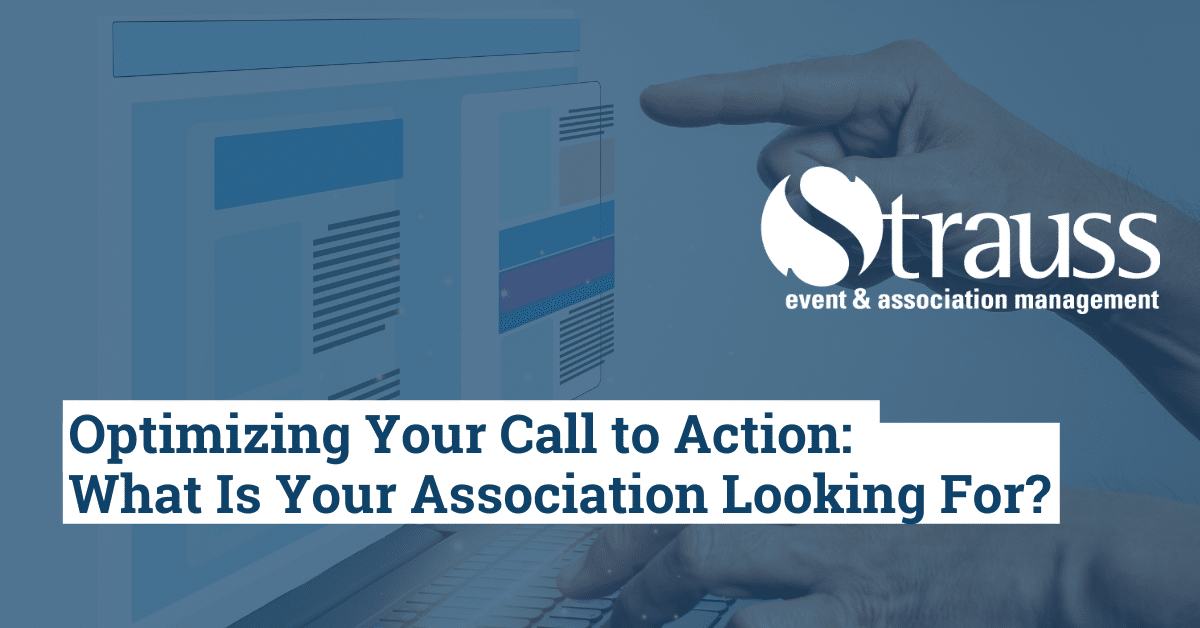Members are an association’s life force. Revenue from membership dues, event attendance, and professional development opportunities keep your association running. So, how can your association secure these revenue sources? If you’ve sent an eblast to your association’s members before, you probably know what a call to action is. However, telling your audience what you want from them only scratches the surface of what you can achieve with a call to action.
Email Communication
When sending an eblast to members, you most likely have a desired outcome in mind. Maybe you want your audience to register to attend an event. Maybe you are sending information to an audience of potential members whom you would like to sign on with your association. Your desired outcome could be as simple as driving traffic to your association’s website. The most important aspect is probably the most obvious: make sure it is possible for your audience to heed your call to action. Ensure that your audience can easily find the links to your goal, and that all the links are working.
Your language should be clear when calling on your members to take a certain action. Make sure that your instructions are straightforward and that there are no confusing grammar issues. Language is critical to the success of your call to action. Approach your call to action with a marketing eye by using the ethos, pathos, logos rule:
- Ethos: appeal to credibility or ethics
- Pathos: appeal to emotions and feelings
- Logos: appeal to logic and reason
If your goal is to encourage potential members to join your association, it might be useful to appeal to their sense of logic. Explain all the benefits of membership and the reasons they should join. Alternatively, you may want to outline your association’s credibility to encourage people to join. If your goal is to ask for donations for a charity, appeal to your audience’s emotions. Tell a story that evokes an image and shows your audience the importance of their donation. Use these marketing tactics to achieve your goals and create a successful call to action.
Read my past article for more on an Association’s Need for Communicative Media.
Website Communication
When advertising events or professional development opportunities on your association’s website, you will likely ask your members to act on some request. This might look like a call for event sponsors or exhibitors. It is here that your communication must be most clear. You must have a very firm understanding of why you want members to act. Otherwise, you will not be able to express your ‘why’ messaging as clearly, and your call to action will not be as effective.
When generating copy for ‘why messaging’, it is crucial to state things simply. Use short sentences. Longer sentences can get out of control and confuse readers, misconstruing the reasons why readers should act on it. If your association is advertising an event, make a short bullet list of the benefits of attending the event. Workshop these bullet points, pick three to six of the best ones, and make them into full, clear sentences. This is your why messaging, and it should be positioned near the top of the webpage as reasoning for the call to action.
Especially on a website, there are many opportunities to create visual cues that lead visitors to the call to action. Firstly, you want your call to action with whatever information attached to be boldly visible. Placement and design also play a big role. Think about the flow of text, visual media, and colour boldness. If most of your text takes up the full width of the page, your call to action should be centered on the page and could be in a boldly visible colour. Draw as much attention to the spot you want visitors to click or read. Think about the flow of text and where your audience’s eyes will be drawn. For example, consider whether your text should be center aligned in certain areas. You can control the flow of text so that it points toward your call to action.
Social Media
The goal for a Facebook, LinkedIn, or Twitter post is engagement. Often, on social media, the call to action takes the form of a link. Unfortunately, simply posting a link after your text isn’t always enough to get audiences to click. For example, when calling for exhibitors to attend an association event, you can write, “Click the link below to secure your booth now!” However, sometimes this is not possible due to character limits. On Twitter, you can only use 280 characters – this includes spaces! Bitly is a great tool for link management. This tool helps you shorten links and even create QR codes, which come in handy when creating images for social media.
Thusly, it is important to include a visual aspect when posting on social media. Without it, your post is much more likely to get skipped over in the feed. Canva is a simple and easy to learn platform for creating graphics and visuals for social media. When designing graphics for your posts, try to keep to your association’s brand. Use the association’s logo, brand colours, and common language. This in combination will make audiences recognize the post from your association while scrolling past. This is also where you can make up for lost copy in the body of your post. Your call to action can be directly in your graphic, making it pop out to audiences even more.
Read my colleague’s article for more Useful Graphic Design Resources for Associations.
Don’t be afraid to experiment when communicating a call to action to your audience. Different associations serve different people, all of whom respond in many ways to appeals. It’s up to you to find what methods garner the best response from your membership, the public, or both.

